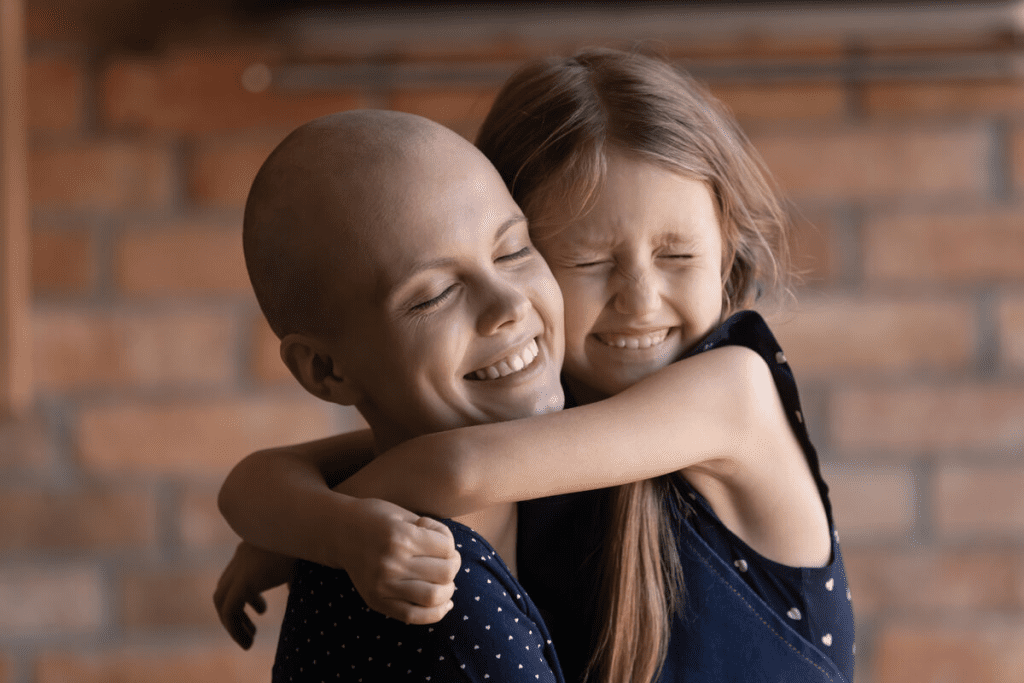Last Updated on November 13, 2025 by
Detailed statistics on the life expectancy of pediatric cancer patients are provided, broken down by the leukemia survival rate by age at diagnosis.
The life expectancy of a child with cancer has greatly improved. This is thanks to new medical discoveries and better care. By 2019, the 5-year survival rate for kids with cancer was about 85%. This is up from 63% in 1975.

The American Cancer Society says 85% of kids with cancer survive 5 years or more after being diagnosed. We’re seeing a big change in how long kids with cancer live. Better treatments and care have made a huge difference.
Childhood cancer used to be a scary diagnosis. But thanks to research and better care, survival rates have greatly improved. The journey of survival rates for childhood cancer is amazing. It shows how treatments, early detection, and care have gotten better.

In 2023, the 5-year survival rate for childhood cancer has seen a big jump. Now, childhood leukemia has a 5-year survival rate of over 86%. Lymphoma, another common cancer in kids, also has good news, with survival rates near 94%.
These numbers mean kids are living and thriving because of the care they get. The American Cancer Society says the 5-year survival rate for childhood cancer is now 85%. This is up from 63% in the mid-1970s. This shows how far medical science has come and the hard work of healthcare professionals.
The rise in survival rates for childhood cancer shows the never-ending search for better treatments and care. From 63% in 1975 to 85% in 2019, it’s clear modern medicine is making a big difference. At Liv Hospital, we aim to keep improving by using innovative and caring methods.
We focus on giving kids with cancer the best support and treatments. Our goal is to keep making progress in pediatric oncology. We’re hopeful for even better survival rates in the future.
Childhood leukemia survival rates have greatly improved. The age of the child and the type of leukemia are key factors. Leukemia is the most common cancer in kids, with Acute Lymphoblastic Leukemia (ALL) being the most common type, says the expert.
ALL survival rates have greatly improved, mainly for kids under 15. Treatment for ALL has gotten better over time. Now, the five-year survival rate is over 90% in many cases. Age-specific care is key to treating ALL well.
Acute Myeloid Leukemia (AML) is less common in kids but has a different outlook. It often needs intense treatment, like chemotherapy and sometimes bone marrow transplants. The survival rate for AML varies by age, with younger kids usually doing better than adults.
Age is very important in how well leukemia patients do. Kids under 5, and even more so under 1, have different outlooks than older kids. At Liv Hospital, we focus on age-specific care to meet each child’s needs. This has greatly improved the average lifespan for leukemia patients.
Knowing the life expectancy after chemotherapy is vital for families. Better chemotherapy and care have boosted long-term survival rates. We help families manage treatment’s long-term effects, so kids can live healthy lives after treatment.
Childhood leukemia survival rates have seen a big jump, giving hope to families everywhere. The American Cancer Society says the 5-year survival rate for kids with leukemia is over 86%. This shows how far medical research and treatments have come.
The 5-year survival rate is key to understanding how well kids with leukemia do. It shows the percentage of kids who live at least 5 years after being diagnosed. Recent data shows this rate keeps going up, thanks to better treatments and early detection.
Looking at long-term survival is just as important as the 5-year rate. Better treatments have not only helped kids survive longer but also live better lives. At Liv Hospital, we aim for our young patients to have healthy, happy lives after treatment.
Many things affect how well kids with leukemia do. These include the type of leukemia, how old they were when diagnosed, and how well they respond to treatment. Knowing these helps doctors create treatment plans that fit each child’s needs, improving their chances.
At Liv Hospital, we’re dedicated to top-notch healthcare and support for our international patients. Our teams work together to give each child the best care, aiming for the best outcomes for kids with leukemia.
Children’s cancer survival rates have greatly improved, changing with each cancer type. At Liv Hospital, we understand the importance of these differences. We aim to give the best care possible.

Lymphoma, a cancer of the lymphatic system, has seen a big jump in survival rates. Now, the 5-year survival rate for lymphoma is almost 94%. This shows how far treatment has come.
Early diagnosis and tailored treatment plans are key to these successes. Recent studies show that kids under 14 tend to do better than teens and young adults. Knowing this helps us tailor care to each child’s needs.
Brain and central nervous system (CNS) tumors are harder to beat, with a 5-year survival rate of around 60%. These tumors need multidisciplinary care teams and new treatments.
“The management of brain and CNS tumors in children requires a highly specialized approach, involving neurosurgeons, oncologists, and rehabilitation specialists,” notes a leading pediatric oncology expert.
At Liv Hospital, we’re working hard to improve outcomes for these patients. We’re always looking to advance in surgery, radiation, and chemotherapy.
Bone cancers, like osteosarcoma and Ewing’s sarcoma, have seen better survival rates thanks to new treatments. Multimodal treatment approaches combine surgery, chemotherapy, and sometimes radiation. This has led to better patient outcomes.
We at Liv Hospital are committed to giving full care to children with bone cancer. We use the latest research and treatments to boost survival rates and quality of life.
When a child is diagnosed with leukemia, it starts a tough journey. This journey includes lots of treatment and care afterward. At Liv Hospital, we know how hard this journey is. We’re here to help with all the care you need.
Getting a leukemia diagnosis means many tests to find out what type and stage it is. The American Cancer Society says treatment for leukemia has several steps. The first step is induction therapy, aiming for remission.
Induction therapy is the first treatment to kill leukemia cells. It can last a few weeks.
Once in remission, maintenance therapy helps keep it that way. This treatment is less intense and can last months to years, depending on the leukemia type.
It’s important to keep an eye on things during this time. We stress following the treatment plan and coming in for check-ups.
Even with good treatment, leukemia can come back. If it does, treatment might change. Knowing about relapse scenarios and possible outcomes helps with planning and making choices.
At Liv Hospital, we’re here for you at every step. Our team works with families to tackle leukemia treatment challenges. We aim to support you from diagnosis to survivorship.
Cancer treatments like chemotherapy, radiation, and surgery have greatly improved life expectancy for kids with cancer. At Liv Hospital, we know these treatments save lives but can also affect health later on.
It’s important to understand how these treatments impact life expectancy. We’ll look at how chemotherapy, radiation, and surgery affect kids with cancer.
Chemotherapy is key in fighting many cancers, including leukemia. The impact of chemotherapy on life expectancy depends on the cancer type, its stage, and how well the treatment works. Life expectancy after chemotherapy also depends on late effects.
Some kids may face long-term issues from chemotherapy, like neuroendocrine problems or secondary cancers. At Liv Hospital, we watch for and manage these effects to help our patients stay healthy.
Radiation therapy is vital for treating some cancers. The effects of radiation on life expectancy depend on the dose and area treated. We carefully plan to reduce long-term risks.
Life expectancy with leukemia can improve with the right treatment, including radiation. But radiation can cause late effects like growth issues or a higher risk of secondary cancers.
Surgery is key to treating some cancers, like brain or bone tumors. Success in surgery can greatly improve life expectancy, with some patients living long-term.
At Liv Hospital, we focus on a team approach to cancer care, including surgery. Our team works together to give patients full care, addressing both the cancer and its long-term effects.
Understanding how long you live with leukemia or other cancers involves looking at different treatments and their effects. We aim to improve life expectancy and quality of life for our patients through quality care and support.
Childhood cancer survival rates differ greatly around the world. High-income countries see survival rates over 80%, while low-income countries struggle with rates below 30%. This gap shows the real challenges in getting children the care they need.
In high-income countries, children with cancer have a high chance of being cured. But in low-income countries, the survival rate is much lower. This difference is a big problem that needs urgent action.
The American Cancer Society says many factors cause this gap. These include access to healthcare, the number of treatment centers, and how much money families have.
“The gap in childhood cancer survival rates between high-income and low-income countries is a moral and medical imperative that demands immediate attention and action.”
One big reason for the survival rate gap is the lack of specialized care in low-income countries. This includes:
To fix these problems, we need a team effort. Governments, international groups, and healthcare workers must work together to improve healthcare systems.
There are efforts to close the gap in childhood cancer survival rates. These include:
At Liv Hospital, we’re part of these efforts. We want to make sure every child gets the care they need, no matter where they are. Together, we can change the lives of children with cancer all over the world.
Childhood cancer survivors start a new journey after treatment. This journey is filled with challenges and chances for growth. At Liv Hospital, we know that care after treatment is just as important as the treatment itself. We address the many needs of our young patients.
About two-thirds of childhood cancer survivors face late effects. These effects can change their quality of life a lot. They can include physical disabilities, cognitive issues, and even secondary cancers.
For example, leukemia survivors might deal with specific challenges related to their leukemia life expectancy after chemotherapy.
We stress the need for long-term follow-up care to manage these late effects. Our survivorship programs are made to meet each survivor’s unique needs. We ensure they get the support they need to live fulfilling lives.
Childhood cancer survivors are more likely to get chronic health conditions. These can include heart disease, diabetes, and secondary cancers. It’s key to monitor and prevent these conditions.
For instance, lymphoma survivors might need to watch for long-term effects that could affect their lymphoma survival rate by age.
At Liv Hospital, we create personalized care plans. These plans include ongoing monitoring and support to help survivors manage their health well.
The effects of cancer on children’s psychosocial and developmental health are significant. Survivors might struggle with anxiety, depression, and challenges in school and social settings. We understand the importance of addressing these issues in survivorship care.
Our teams include psychologists, social workers, and educators. They work together to support survivors’ emotional and developmental needs. We aim to improve their overall well-being and life expectancy after chemotherapy.
In conclusion, the journey of a childhood cancer survivor is complex and multifaceted. At Liv Hospital, we are dedicated to giving the care and support needed. We want our survivors to thrive in the years after treatment.
Leukemia survivors face new challenges after treatment. They must deal with long-term health issues. Overcoming leukemia is a big win, but the journey continues.
Leukemia survivors can live for many years after treatment. But their life span depends on several factors. These include the leukemia type, age at diagnosis, and treatment.
Studies show that better treatments have improved survival rates. For example, the five-year survival rate for ALL in children has greatly increased. AML treatment has also seen improvements, though outcomes can vary.
Leukemia survivors face a high risk of secondary cancers. This is due to chemotherapy and radiation therapy. Long-term care is key to catching these cancers early.
Some secondary cancers include:
Regular check-ups and screenings are essential for early detection and treatment.
Leukemia treatment can harm the heart and endocrine system. Some chemotherapy drugs and radiation can cause heart disease. Endocrine issues can affect thyroid function and growth in children.
At Liv Hospital, we stress the need for long-term care. This includes:
By focusing on long-term care, leukemia survivors can live healthier, happier lives.
Knowing how long you can live with untreated cancer is key to making care choices. The disease’s progression changes a lot based on the type and stage. Knowing how cancer acts on its own helps in making better decisions.
The life span of someone with untreated cancer depends on many things. These include the cancer type, its stage, and the person’s health. For example, leukemia life expectancy changes a lot based on the type, age, and how well the body responds to treatment.
Some cancers, like certain types of leukemia, grow fast if not treated. Others may grow more slowly. It’s vital for patients and their families to talk to doctors to understand their disease’s likely path.
When a cure is not possible, palliative care is very important. It aims to ease the symptoms and stress of serious illnesses. The goal is to enhance the quality of life for patients and their families.
Palliative care teams help manage pain, nausea, and other symptoms. They also support emotional, social, and spiritual needs. At Liv Hospital, we offer compassionate palliative care that meets our patients’ physical, emotional, and social needs.
Quality of life is very important for those with untreated cancer. As the disease gets worse, keeping comfortable and dignified becomes more critical. Palliative care helps manage symptoms and improve daily functioning.
We create personalized care plans with patients and their families. By focusing on quality of life, we help patients live their final days with dignity and comfort.
At Liv Hospital, we are committed to top-notch care for kids with cancer. We use the newest in pediatric oncology. Our goal is to give every child the best care possible.
We are proud of our international-caliber treatment protocols. They are always updated with the latest in pediatric cancer treatment. Our protocols help our young patients get the care they need to survive and live well.
“Our treatment protocols show our dedication to world-class care,” says a team member. “We aim to give every child the best treatment, backed by the latest research and trials.”
Our pediatric cancer care is led by a multidisciplinary team of experts. This team includes pediatric oncologists, surgeons, radiologists, nurses, and more. They all work together to provide care that treats the whole child, not just the cancer.
We are always working to improve patient outcomes. This is through research, clinical trials, and quality improvement. We aim to not just increase survival rates but also to improve the quality of life for our patients.
By focusing on life expectancy after chemotherapy and other key metrics, we refine our treatment plans. This helps us provide the best outcomes for kids with leukemia and other cancers. Our commitment to top-notch care is strong, and we keep pushing the limits in pediatric oncology.
The fight against childhood cancer is getting better, thanks to new treatments and care plans. At Liv Hospital, we aim to give top-notch healthcare. This helps kids live longer and better lives.
Looking ahead, we see better chances for kids with lymphoma and leukemia. Our team works hard to help kids from all over get the best care. We’re all about making sure every child gets the support they need.
We’re hopeful for the future of childhood cancer treatment. Research and global efforts are closing the gap in survival rates. Together, we can make a big difference in the lives of kids with cancer.
As of 2019, the 5-year survival rate for pediatric cancer is about 85%.
The 5-year survival rate for childhood leukemia has greatly improved. It now stands at over 86%.
ALL survival rates have improved a lot, with children under 15 doing well. AML, on the other hand, needs more intense treatment.
Age is very important in how well children with leukemia do. Younger kids usually have better chances of survival.
Lymphoma survival rates have greatly improved. The 5-year survival rate is now close to 94%.
How long someone lives with untreated cancer depends a lot on the type and stage of cancer.
Survivors may face risks like secondary cancers, heart problems, and issues with the endocrine system. They also face chronic health conditions.
The type of leukemia, along with age at diagnosis and treatment response, greatly affects outcomes.
In high-income countries, cure rates for childhood cancer are over 80%. But in low-income nations, they are below 30%. This is mainly because of a lack of access to specialized care.
Survivors need ongoing care to manage late effects. This includes chronic health conditions and psychosocial and developmental considerations.
Liv Hospital aims to provide top-notch care. They offer full support for international patients, ensuring every child gets the best care possible.
Palliative care is vital when a cure is not possible. It focuses on improving the quality of life for patients.
Subscribe to our e-newsletter to stay informed about the latest innovations in the world of health and exclusive offers!